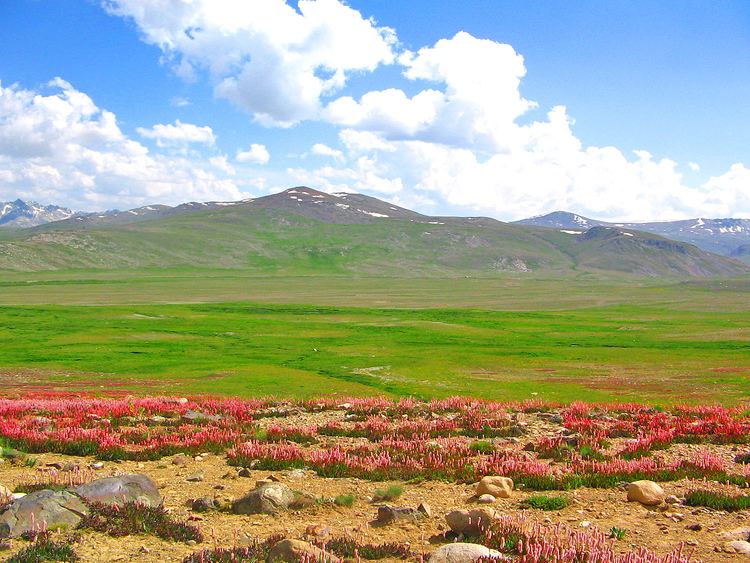Nearest city Skardu Established 1993 | Area 3,000 km² | |
 | ||
Governing body Directorate of Deosai National Park Sadpara Road, Skardu Similar Shangrila Resort, Sadpara, Skardu Airbase, PTDC Motel Skardu, Vertical Explorers Expeditio | ||
Deosai national park home of the himalayan brown bears
The Deosai National Park is located in between Skardu, Gultari, Kharmang and Astore Valley, in the Gilgit-Baltistan region of Pakistan, the majority of which falls in Skardu district.
Contents
- Deosai national park home of the himalayan brown bears
- Deosai national park skardu northern areas of pakistan documentary
- Etymology
- Geography
- Geology and soil
- Travel routes to the region
- Sheosar Lake
- Fauna and Flora
- References
Deosai national park skardu northern areas of pakistan documentary
Etymology
The Deosai National Park is located between Astore and Skardu, PoK. 'Deosai' (Urdu: دیوسای٘) means 'the land of Giants' in Urdu. Balti people call this place 'Ghbiarsa' (غبیارسہ) referring to 'Summer's Place' because it is only accessible in summer.
Geography
Deosai National Park falls in Skardu Baltistan and has an average elevation of 4,114 metres (13,497 ft) above sea level, making the Deosai Plains one of the highest plateaus in the world. The park protects an area of 3,000 square kilometres (1,200 sq mi). It is well known for its rich flora and fauna of the Karakoram-West Tibetan Plateau alpine steppe eco region. In spring, it is covered by sweeps of wildflowers and a wide variety of butterflies. Deosai is second highest plateau after Chang Thang Plateau Tibet.
Geology and soil
The soils of this area are severely eroded, of a coarser nature and mixed with gravel and stones of various material and sizes. In flat areas between mountains, soil is deep with marshy vegetation.
Travel routes to the region
Deosai is accessible from Skardu District in the north, Gultari Kharmang district in the south-east, and the Astore District in the west. Deosai is located approximately 30 km from Skardu city and it is the shortest route to visit Deosai. Most foreigners visit deosai via Skardu. It takes 1 hour to reach Deosai top via Sadpara Skardu. Another route is from Astore valley via Chilim. It is also accessible from Shila valley. The people of Gultari travel via Deosai. There is another route called Burgi la via Tsoq Kachura valley Skardu.
Sheosar Lake
There is a lake in Deosai Park, named Deosai Lake, or Sheosar Lake, meaning "Blind Lake". The lake, at an elevation of 4,142 metres (13,589 ft), is one of the highest lakes in the world. Its length is 2.3 kilometres (7,500 ft), width 1.8 kilometres (5,900 ft) and average depth 40 metres (130 ft).
Fauna and Flora
The Deosai National Park was established in 1993 to protect the survival of the Himalayan brown bear and its habitat. Having long been a prize kill for poachers and hunters, the bear now has a hope for survival in Deosai where its number has increased from only 19 in 1993 to 40 in 2005. During the last decade, a few but effective measures have been taken by the Government of Pakistan for the survival of brown bear in the region. In 1993, Himalayan Wildlife Project was founded with a substantial financial support from international environmental concerns. But the brown bear is still under threat.
The Deosai Plains are also home to the Himalayan ibex, red fox, golden marmot locally called Phia, gray wolf, the Ladakh urial, the snow leopard, and over 124 resident and migratory birds. Birds in the park include the golden eagle, lammergeier, griffon vulture, laggar falcon, peregrine falcon, kestrel, sparrowhawk and snowcock. The following species are found in Deosai Artemisia maritima, Polygonum affine, Thalictrum alpinum, Bromus oxyodon, Saxifraga flagellaris, Androsace mucronifolia, Aster flaccidus, Barbarea vulgaris, Artemisia maritima, Agropyron longearistatum, Nepeta connate, Carex cruenta, Ranaculyus laetus, Arenaria neelgerrensis, Astrogalus leucophylla, Polygonum amplexinade, Echinop nivetus, Seria chrysanthenoides, Artemisia maritima, Dracocephalum nutsus, Anapalas contorta, Chrysopogon echinulatus, and Dianthus crinitus. There were also observed some medicinal plants which are locally famous i.e. Thymu linearis (Reetumburuk), Saussures lappa (kuth), Ephedra intimedia (Say), Viola canescens (Skora-mindoq), Dracocephalum muristanicum (Shamdun) and Artemisia maritima (Bursay) etc. are used as traditional drug therapies.
